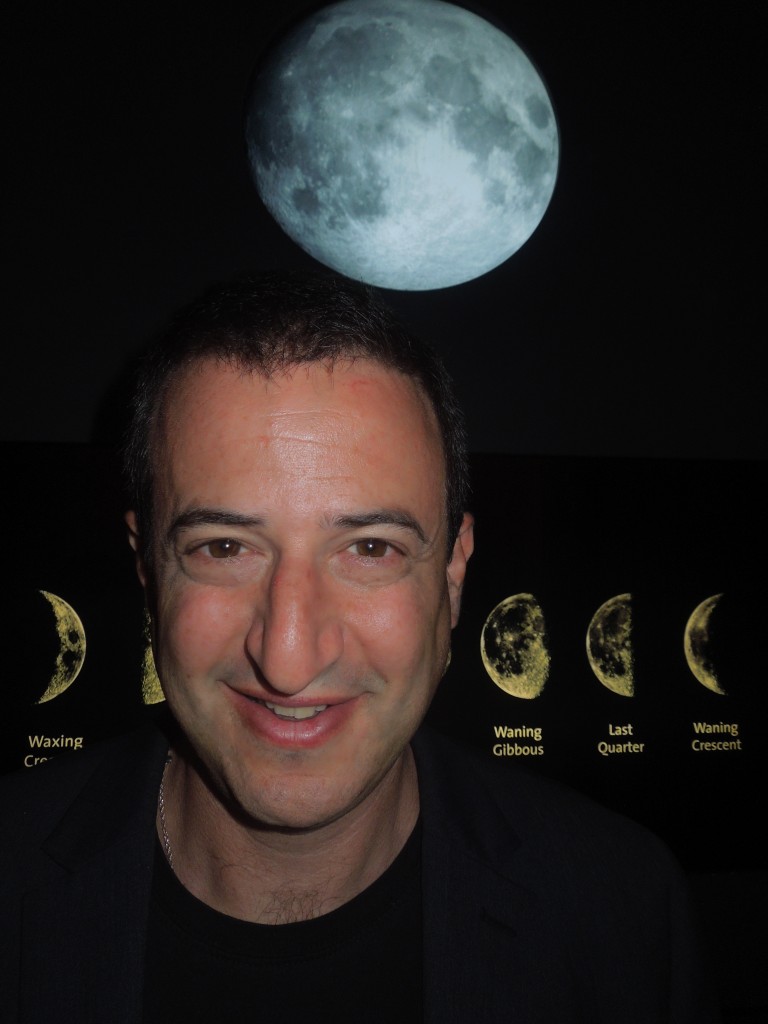Interview With Ari Popper, CEO of the Coolest Company In The World: ''SciFutures''
Monday, October 15, 2012, 7:35 am




Posted in category Behavioral Economics, Big Data, Business Leadership, Co-creation, Consumer Anthropology, Consumer Behavior, Consumers, Contributors, Data Visualization, Economic Trends, Gamification, General Information, Human Capital, Hybrid Approaches, Industry News, Industry Trends, innovation, Innovation in Market Research, Leadership, Market Research, Market Research Techniques, Mobile Research, Neuromonitoring, Respondent Engagement, Social Media, State of the Industry, Strategy, Technology, Transformation, Trends
No Comments
Hired guns of sci-fi shaping our future
The Times-4 小時前
Ari Popper, founder of SciFutures, sells sci-fi short stories to businesses to help them develop corporate strategies. He has built a stable of more ...
Better Business Through Sci-Fi
The New Yorker-2017年7月30日
About five years ago, Ari Popper enrolled in a course on science-fiction writing at the University of California, Los Angeles, hoping to distract ...
Do Sci-Fi Writers Dream of a Corporate Payday?
Inverse-10 小時前
CEO Ari Popper told the New Yorker that the consulting firm deals in “corporate visioning,” which means that the stories they produce for clients ...
Forecasting the Future is Becoming Big Business for Sci-Fi
Space.com-2017年1月19日
The future is not that far off, and many professional forecasters in Washington make a living out of predicting the kind of world we might inhabit ...
An interview with Ari Popper of SciFutures on using science fiction story telling as a path to help brands understand and create the future.
 I’m sure most of you are familiar with BrainJuicer, and if so then you probably know Ari Popper, former MD of North America. I met Ari several years ago and immediately came to the conclusion that here was one smart and very cool guy, and every interaction since then has only reinforced that impression. Now Ari has launched a new venture that should communicate that to the world, and I think it’s one that GreenBook Blog readers in particular will find to be very exciting and interesting.
I’m sure most of you are familiar with BrainJuicer, and if so then you probably know Ari Popper, former MD of North America. I met Ari several years ago and immediately came to the conclusion that here was one smart and very cool guy, and every interaction since then has only reinforced that impression. Now Ari has launched a new venture that should communicate that to the world, and I think it’s one that GreenBook Blog readers in particular will find to be very exciting and interesting.As usual, this interview was conducted via email over the course of a few days.
I hope you enjoy reading it as much as Ari and I did conducting it. I also expect you’ll understand why I called his new company, SciFutures, the coolest company in the world.
LFM: Thanks for making the time Ari, it’s good to reconnect. So, you recently left BrainJuicer as a highly successful run as MD of America and have launched a new venture. What prompted the change and what can you tell us about your new adventure?
AP: Hi Lenny, my pleasure. Well, I am completely obsessed with the extreme potential of the times that we live in. We live in a time, as the techno philosopher Jason Silva says, where we are quickly becoming as powerful as gods. We can see through walls, video conference while traveling at 30,000 ft and at 300mph, engineer individual cells and atoms. The average person in Africa has access to same amount of information as President Clinton did 20 years ago. A surgeon in the USA can operate on a wounded soldier in Iraq. And it is only going to get even more intense as we are seeing exponential growth in information technology; bio-tech (which actually is advancing faster than Moore’s Law) and nano tech. It took 3 years for the first billion tweets and now there are one billion tweets every 2-3 days. Instagram was bought for $1bill and it was only 19 months old. It is clear to me that we now have the unprecedented opportunity to make radical and profound changes to the world we live in. This obsession has been gnawing at me for many years and so I finally decided set up consultancy that leverages the most powerful assets available to us as business people: our creativity and imagination in combination with these stunning technological breakthroughs. What I am passionate about is helping our clients disrupt themselves into a better existence before a competitor disrupts them out of existence.
LFM: Now, I am a widely renowned uber-geek, so the idea of a consultancy grounded in science fiction is right up my alley! How did you arrive at this particular model?
AP: I am an amateur sci-fi writer and I had the pleasure of doing a fantastic sci-fi writing course at UCLA offered by my now business partner Professor Mike Buckley. I loved it so much I did it twice! What became clear to me was that science fiction or if you prefer the term, speculative fiction, provided the most amazing forum or mechanism for generating innovative ideas. Hard sci-fi is my preferred genre as it is grounded in real science. I love the power of science fiction to render worlds that are entirely plausible and yet magical at the same time. One day in class, I realized that this power can be used to help businesses radically disrupt their thinking and more importantly inspire the creation of visceral and engaging stories that can then be transformed into winning business strategies. The power of this approach is two-fold: firstly the sci fi or storytelling process generates remarkable ideas grounded in fact or emerging technologies. Secondly, the storytelling aspect of it leverages the oldest and most powerful aspect of human engagement. (Jonathan Gottschall writes in his brilliant book, The Storytelling Animal that humans are hard wired for stories). Stories are data with soul. And it is stories that ensures we suspend disbelief (as Gottschall says, fiction is far more effective at changing belief than non-fiction). As you know Lenny, the power of stories is becoming an important topic in the MR industry and I believe we haven’t even scratched the tip of the iceberg in terms of leveraging their potential. SciFutures leverages this power to help our clients disrupt their thinking and then to “storify” strategy for a significant and durable competitive advantage.
LFM: Can you describe a typical SciFutures engagement?
 AP: Well, our engagements are designed to help our clients achieve their specific objectives and therefore vary for each client. However, there are certain elements that are consistent. The first is that everything we do is grounded in fact, data (especially emerging technology that is already transforming the world such as 3D printing, augmented reality, internet of things etc) and of course, powerful consumer insights. The second is we have created a wonderfully engaging process using gaming mechanisms to help our clients express their imaginations and the imaginations of our talented sci-fi writers (since even Einstein acknowledged that “Imagination is more important than knowledge”). The brilliant economist Richard Florida says that the ability to harness creativity is the single greatest source of wealth creation. Finally, we co-create engaging stories and then reverse engineer these stories into business strategies by mapping out a step by step process to help our clients bring these scenarios to life.
AP: Well, our engagements are designed to help our clients achieve their specific objectives and therefore vary for each client. However, there are certain elements that are consistent. The first is that everything we do is grounded in fact, data (especially emerging technology that is already transforming the world such as 3D printing, augmented reality, internet of things etc) and of course, powerful consumer insights. The second is we have created a wonderfully engaging process using gaming mechanisms to help our clients express their imaginations and the imaginations of our talented sci-fi writers (since even Einstein acknowledged that “Imagination is more important than knowledge”). The brilliant economist Richard Florida says that the ability to harness creativity is the single greatest source of wealth creation. Finally, we co-create engaging stories and then reverse engineer these stories into business strategies by mapping out a step by step process to help our clients bring these scenarios to life.LFM: Your engagements sound pretty intense; do you normally hold these as seminars or retreats? Have you considered incorporating your technique into other events such as conferences?
AP: We have found that a workshop model works really well. We recently conducted a very successful offsite for Pepsi in a gorgeous mansion in the hills of Pasadena! The choice of location is important as it adds a lot to the creative process. We would certainly incorporate our approach into conferences – a great idea.
LFM: So is your focus primarily on the co-creation/ideation and strategy mapping aspect of the engagement, or are you working with clients to identify the resources and potential partners to bring the ideas to life as well?
AP: What makes this so exciting is that it is both those areas plus we are working on plans to go even further. On the one hand we help generate radical ideas and strategies and on the other hand, we help implement these ideas. We currently have a proposal to help conceive and also to implement augmented reality solutions. We also have plans to help create “experiential futures” spaces where we construct physical spaces such as “the kitchen/ living room/ store of the future”. This is central to our philosophy that in order to create and understand the future, you have to be immersed and fully embedded in the narrative of that future.
LFM: I am a big believer in the self-fulfilling prophetic aspects of science fiction; certainly the great classic visionaries like Jules Verne, Aldous Huxley, Frank Herbert, Isaac Asimov, Philip K. Dick, Gene Rodenberry, Arthur C. Clarke, William Gibson and Robert A. Heinlein have inspired (and continue to inspire) the tech and business revolutionaries of today. Yesterday’s science fiction is today’s science fact (or will be very soon in many cases). Can we visualize what the new frontiers will be now that we’re so far down the paths these greats foresaw many years ago?
AP: Exactly. We are in the business of actively leveraging custom sci-fi narratives to generate self-fulfilling prophecies. SciFutures is not about predicting the future in the conventional sense. Any examination of the SF literature shows many examples of poor predictions. There are also wonderfully accurate predictions of the future but we not interested in making predictions. Victor Hugo said there is nothing more powerful than an idea whose time has come. What we are interested in is using high quality speculative fiction to inspire plausible and compelling futures. We are in the business of using storytelling to transform abstract, vague and sometime highly technical ideas into living, breathing, and visceral realities. Our process helps ripen ideas and in turn, generates a compelling and much more accessible future pathway for our clients. Fiction is far more effective at changing belief than non-fiction. Great SF writers take ideas and turn them into plausible, compelling and exciting visions of the future. This aspect of the futures and the foresight industry is under leveraged and what we feel provides our clients with a significant competitive advantage.
LFM: BrainJuicer is renowned as one of the most innovative research firms in the world today; how did your time there inspire your thinking about SciFutures and what do you think the next great innovation for MR will be?
AP: BrainJuicer is that rare gem of a company as it values creativity as much as pragmatism; it is unafraid to take risks and to lead and therefore has successfully brought to market genuinely innovative solutions. I was privileged to work with some of the most brilliant minds in our industry and my experience there inspired me to start SciFutures.
So to answer your question on the Future of MR, due to the exponential improvement in information technology and advances in neuro science, I think the world of “Neuro Big Data” is where the future of MR lies.
In the spirit of SciFutures here is a very short story that incorporates this emerging tech and brings a vision of it to life. Hopefully it inspires a research agency to create it!
LFM: I love it! What a cool treat; thank you Ari. OK, so let’s play along with that a bit; it sounds like you embrace the Singularity hypothesis of Kurzweil, and with the advances in augmented reality, new devices like Google Glasses, neuroimplants for healthcare, etc… I agree we’re not too far off. Now here is the big question; since so much of the “normal of tomorrow” is being worked on in the “skunk works labs” of today, how can we align brands and these visionaries so they can even begin to imagine what is possible?
In 15 minutes, Jack’s meeting with his unpredictable boss, the uptight CMO of a struggling retail company, was about to start. She needed fresh ideas. She needed actionable insight. And, as always was the case in his company, she needed it yesterday.
His Robo PA was reading his neural activity and so it sensed the upcoming meeting and automatically issued a “do not disturb” aura so that Jack’s colleagues around the world were now unable to access his public mind feed. It didn’t matter. His colleagues knew better than to interrupt him before big meetings, particularly these last few months when the numbers had been particularly poor. Amazon’s Augmented Reality Shopping App was barely 6 months old but it was wreaking havoc on same store comparable sales versus last year. His company was in a tailspin and desperate for solutions. Luckily, just before he went into private mode, his wife sent him a neural stim packet that he gratefully opened to receive a simulated burst of “warm hugs and good luck” feelings as his jacked in limbic system oozed it out into his mind and body.
Yet, today was going to be different. Jack was excited. He had recently discovered a research agency that could finally deliver what his CMO calls – Holy Grail Behavioral Insights. And so, for the 5th time that morning, Jack said confidently: “Presentation practice run through”.
Like magic, Jack was transported back into one of the pilot research stores, store #55 in Mall of America. As he virtually stood in the store, 3 months of customer behavioral data (walking, lingering, browsing, buying and employee interactions) were toggled on and off and superimposed onto the physical store via verbal commands and slight flicks of his wrist. [For the past quarter, cameras had been capturing shopper behavior, monitoring why and what they buy as well as reading their facial expressions and emotions as they entered the parking lot and up until they returned to their self driving cars]. The superimposed behavioral and emotional data was brought to life and visualized in 3D with thickness of lines indicating “most walked pathways” and the colors of the lines indicating aggregate feelings by type. Jack instantly saw and felt where customers were happiest, what they were buying and which associates were the most helpful. He was literally inside the insights and, in a way; the insights were also inside him. Most importantly, he now had specific suggestions and plans how to improve store #55′s shopping experience and to drive sales.
He felt ready for his big meeting but apparently the meeting was already over as his CMO was standing next to him in store #55 with eyes wide open and a huge grin on her face.
AP: Well as a start they should hire SciFutures. Seriously though, I think the most important first step is to realize how dynamic the business environment is and how quickly the world is changing. This is not the time for heads in the sand and hoping that everything will stay the same. It won’t. If this awareness sinks in, then I think the climate will be ripe for new ideas, creative approaches to futures work and self-disruption. I recently heard this quote by the theologian James Carse and it is directly relevant to staying relevant: “Finite players play within boundaries. Infinite players play with boundaries.”
LFM: So what is next for SciFutures? How do you see the business scaling and what do you think the model will look like in 24 months?
AP: Hopefully we will have our own exponential growth and we will be flexible and open to feedback, since feedback is a precious gift. My time at BrainJuicer taught me that the best approach to growing a business is to try different approaches, to make mistakes, to adapt and to learn. This includes most aspects of the business including the business model. However, as a consultancy, the most important thing of all is laser sharp focus on delighting our clients. The rest usually takes care of itself.
LFM: OK, last question and pitch time Ari. Tell our readers whatever you think they need to hear to be convinced that SciFutures that will help them gain competitive advantage. Go!
AP: Ha. If your readers are not interested by now, I am not sure there is much more I can say but I’ll quote Mark Cuban: “If you are looking for the next best thing and looking where everyone else is, you are looking in the wrong place.” SciFutures will show you how to look in a very different place. Thanks for the interview Lenny – I had great fun doing this!





